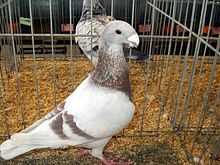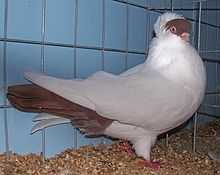Fancy pigeon
Fancy pigeons are domesticated varieties of the Rock Pigeon. They are bred by pigeon fanciers for various traits relating to size, shape, color, and behavior,[1] who often exhibit their birds at pigeon shows, fairs and other livestock exhibits.[2]
There are about 800 pigeon breeds; considering all regional varieties all over the world there may be 1100 breeds.[3] The European list of fancy pigeons alone names about 500 breeds.[4] No other domestic animal has branched out into such a variety of forms and colours.[5]
Charles Darwin is known to have crossbred fancy pigeons, particularly the Ice Pigeon, to study variation within species,[6] this work coming three years before his groundbreaking publication, On the Origin of Species.
Pigeon showing
Pigeon fanciers from many different countries exhibit their birds at local, inter-state or national shows and compete against one another for prizes.[1] One typical country show in Australia in 2008 had hundreds of pigeons on display and prizes for the winners.[7]
Some fanciers organize exhibitions exclusively for pigeons; one held in Blackpool run by the Royal Pigeon Racing Association is annually attended by about 25,000 people and generates around £80,000 profit, which is donated to charity.[8]
The largest pigeon show is held in Nuremberg: the German National Pigeon Show, which had over 33,500 pigeons at the 2006 show.[9]
In the United States, there are hundreds of local, state and national pigeon clubs that sponsor shows. The largest shows are the National Young Bird Show, held in Louisville, Kentucky in October, and the National Pigeon Association's Grand National, held in a different city each year and usually in January.
Major breed families of fancy pigeon
This grouping system is adapted from The Australian Fancy Pigeons book of standards.[10] Consideration was given to the new UK standards book which followed the German and European grouping. This version differs slightly from that of the European grouping; the following system is arbitrary and used solely for organizing breed articles until a grouping can be accepted worldwide.
Asian feather and voice pigeons
.jpg)
This group includes breeds developed for extensive feathering that originated in the Asian region, as well as breeds cultivated for their trumpeting, or laughing, voice.
Colour pigeons
.jpg)
Most of these pigeons originate in Germany, and are sometimes listed as German Toys. There are many different varieties, with a wide selection of colours and markings.
- Archangel
- Danish Suabian
- Saxon Field Pigeon
- Starling
- Swallow
- Thuringen Field Pigeon
- Ice Pigeon
Frills and Owls
.jpg)
The word "frill" here relates to the reversed feathering on the chest of these varieties. This group is also noted for having short beaks.
Homer and Hen Pigeons
Homing Pigeons

This group includes breeds originally developed for their homing ability, and includes show-type racing pigeons.
Pouters and Croppers
.jpg)
This group includes breeds developed for the ability to inflate their crops.
- English Pouter
- Brunner Pouter
- Gaditano Pouter
- Holle Cropper
- Horseman Pouter
- Norwich Cropper
- Pigmy Pouter
- Pouter
- Voorburg shield cropper
- Old German Croppers
Exhibition Tumblers

This group originally consisted of flying/tumbler breeds, but has now been refined to include only purely ornamental/exhibition breeds.
- Budapest Short Face Tumbler
- English Long Faced Tumbler
- English Short Faced Tumbler
- Helmet
- English Magpie
- Nun
Flying Tumblers and Highfliers

This group is dual purpose in that its members can be shown, but also retain acrobatic or sporting ability and can therefore be used in flying competitions. Flying tumbler varieties belong in this group. Although many varieties in this grouping have become primarily show varieties, they are still expected to display characteristics of performing birds.[10]
Utility pigeons

This group includes breeds originally developed as sources of meat.
See also
| Wikimedia Commons has media related to Fancy pigeons. |
References
- ↑ 1.0 1.1 Levi, Wendell (1977). The Pigeon. Sumter, South Carolina: Levi Publishing Co, Inc. ISBN 0-85390-013-2.
- ↑ Blechman, Andrew (2007). Pigeons-The fascinating saga of the world's most revered and reviled bird.. St Lucia, Queensland: University of Queensland Press. ISBN 978-0-7022-3641-9.
- ↑ Schütte, Joachim (1971). "EINLEITUNG". Handbuch der Taubenrassen (in German). Melsungen, Berlin, Basel, Wien: Neumann-Neudamm. ISBN 9783788800116. OCLC 74047160.
- ↑ "EE-list of fancy pigeons (ELFP)". Entente Européenne d’Aviculture et de Cuniculture.
- ↑ Lyell, James C. (1881). Fancy Pigeons. London: Barnes & Noble. OCLC 8005808.
- ↑ Ross, John. "Darwin's Pigeons".
- ↑ "Bird lovers flock to pigeon show" (Web article). Wauchope Gazette. Retrieved 2008-05-22.
- ↑ "Fanciers flock to fund foundation" (Web article). Bebden Bridge Times. Retrieved 2008-05-24.
- ↑ Child, Brad (2007). ""Pigeon Pals Tour" Part II". Purebred Pigeon (March/April 2007). pp. 71, 72..
- ↑ 10.0 10.1 Seymour, Rev. Colin (Ed)(2006) Australian Fancy Pigeons National Book of Standards.
External links
- National Pigeon Association - USA
- Purebred Pigeon Magazine
- National Young Bird Show - USA
- Fancy Pigeon Portraits